Tussock Moth Caterpillar
Tussock moth caterpillars can destroy forests!
Advertisement
Tussock Moth Caterpillar Scientific Classification
Read our Complete Guide to Classification of Animals.
Tussock Moth Caterpillar Conservation Status
Tussock Moth Caterpillar Locations

Tussock Moth Caterpillar Facts
- Prey
- trees, shrubs, ornamentals
- Main Prey
- oak trees, pine trees
- Name Of Young
- N/A
- Group Behavior
- Eclipse
- Fun Fact
- Tussock moth caterpillars can destroy forests!
- Estimated Population Size
- Undetermined
- Biggest Threat
- pesticides
- Most Distinctive Feature
- furry body
- Distinctive Feature
- dotted bodies (some species)
- Other Name(s)
- gypsy moth caterpillar, white-marked tussock moth caterpillar, Douglas fir tussock moth caterpillar, rusty tussock moth caterpillar, et al.
- Gestation Period
- N/A
- Temperament
- docile
- Wingspan
- N/A
- Training
- N/A
- Optimum pH Level
- N/A
- Incubation Period
- 3-days - 1 week
- Age Of Independence
- birth
- Age Of Fledgling
- N/A
- Average Spawn Size
- N/A
- Litter Size
- N/A
- Habitat
- Tussock moths are found in a wide variety of habitats, including forests, woodlands, meadows, and gardens.
- Predators
- Birds, small mammals, parasitic insects
- Diet
- Herbivore
- Average Litter Size
- N/A
- Lifestyle
- Diurnal
- Crepuscular
- Favorite Food
- oak leaves, pine needles
- Type
- Erebidae
- Common Name
- tussock moth caterpillar
- Special Features
- bodies are hairy
- Origin
- Global
- Location
- Global
- Average Clutch Size
- -37
- Slogan
- N/A
- Group
- eclipse
- Nesting Location
- trees
- Age of Molting
- various stages of development
Tussock Moth Caterpillar Physical Characteristics
- Color
- Brown
- Grey
- Yellow
- Black
- White
- Caramel
- Multi-colored
- Skin Type
- Exoskeleton
- Lifespan
- 1 week - 1 year
- Weight
- less than 1 ounce
- Height
- 0.25-0.5 inches
- Length
- 0.5 - 2 inches
- Age of Sexual Maturity
- N/A
- Age of Weaning
- N/A
- Venomous
- No
- Aggression
- Low
View all of the Tussock Moth Caterpillar images!
The tussock moth caterpillar is the larval stage of a tussock moth, which is a type of moth in the family Erebidae. Tussock moth caterpillars are typically fuzzy and have tufts of hair, or tussocks, on their bodies. They can be found in a variety of colors, including white, yellow, orange, and brown. They can be found feeding on the leaves of trees and shrubs, and are considered pests by some farmers and gardeners. This is due to their ability to defoliate trees, as well as entire forests! Keep reading to learn more about these hungry caterpillars!
Five Furry Facts about Tussock Moth Caterpillars
- Tussock moth caterpillars have tufts of hair or tussocks along their bodies, which is their most distinctive feature.
- They are herbivorous, and they feed on the leaves of various trees and plants.
- Vapourer moths (Orgyia antiqua) do not spin cocoons, metamorphosing directly into adult moths.
- They are active during the day and they tend to rest at night.
- They are preyed upon by a variety of predators, including birds, mammals, insects, and some parasitic wasps.
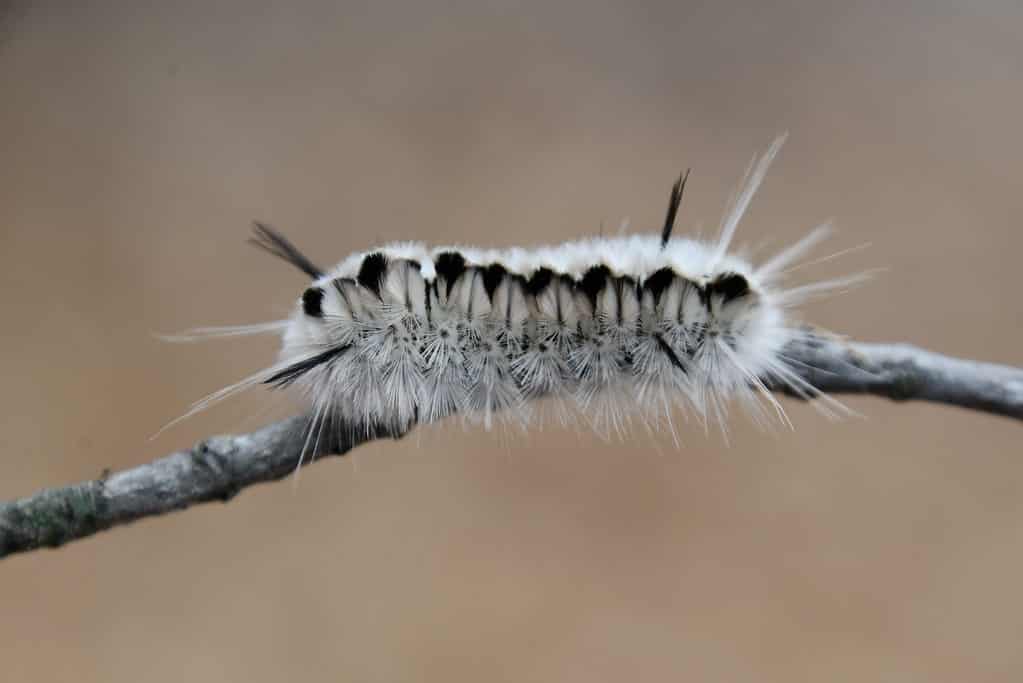
Tussock moth caterpillars are hairy, like this hickory tussock moth caterpillar (
Lophocampa caryae).
©Stephanie Gelman/Shutterstock.com
Scientific Name
Tussock moth caterpillars share their scientific names with their adult moth forms. Tussock moths comprise a large group of moths, of which there are many different species. However, they all belong to the same family, Erebidae. Each species has its own scientific name. The spongy moth (Lymantria dispar), the Douglas-fir tussock moth (Orgyia pseudotsugata), and the White-marked tussock moth (Orgyia leucostigma) are all in the family Erebidae. Erebidae is Greek and loosely translates to out of the darkness. This seems like a fitting name for adult moths, who tend to fly at night. There are 350 genera of tussock moths comprised of more than 2700 separate species! New species continue to be discovered and classified.

The white-marked tussock moth (
Orgyia leucostigma
) is one of over 2000 tussock moth species.
©Satyashutter/Shutterstock.com
Tussock Moth Caterpillars: Appearance
Tussock moth caterpillars are small, fuzzy insects that can vary in color from yellow to brown to black. Many tussock moth caterpillars have urticating hairs, which cause an unpleasant reaction in some individuals. However, reactions tend to be mild, and are the result of an allergic reaction. Tussock moth caterpillars are not venomous. They have tufts of hair, called setae (seta, singularly) or tussocks along their bodies, which are their most distinctive feature. Some species have distinctive markings or patterns on their bodies as well.
They generally range from 0.5 to 2 inches in length. Tussock moth caterpillars are active during the day, tending to rest at night. Some species spin cocoons and metamorphose into adult moths, while others do not form cocoons. Species of the genus Orgyia, such as the vapourer moth (Orgyia antiqua) do not spin cocoons. Instead, they form a pupal case around their body in which they metamorphose into adult moths. Known as a naked pupae. It is a characteristic feature of the genus Orgyia.
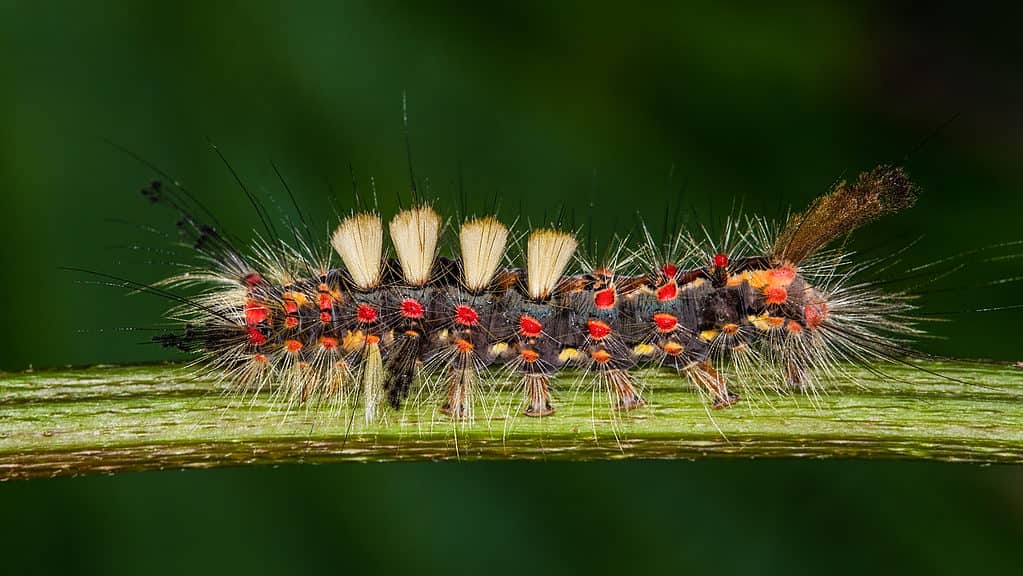
Species of the genus
Orgyia, such as the vapourer moth (
Orgyia antiqua) do not spin cocoons. Instead, they form a pupal case around their body.
©thatmacroguy/Shutterstock.com
Tussock Moth Caterpillars: Habitat
Tussock moths are found in a wide variety of habitats, including forests, woodlands, meadows, and gardens. They are found throughout much of Africa, Asia, Europe, and North America. Some species, such as the spongy moth (Lymantria dispar), are known to occur in both urban and rural areas. They are also known to occupy a wide range of elevations, from sea level to alpine habitats. The caterpillars of some tussock moth species can be found on a variety of trees and plants, including oak, willow, apple, cherry, and many others. Adult moths are generally nocturnal and are attracted to lights
Tussock moth caterpillars are generally diurnal, actively feeding throughout the day. They feed on the leaves of various trees and plants during the day and rest at night. Some species, such as the gypsy moth (Lymantria dispar) and the vapourer moth (Orgyia antiqua) are known to migrate in large groups, which can make their effects on plants even more severe. However, it’s important to note that there could be some variations between different species of tussock moths, as some species might be more active at night or crepuscular.
Tussock Moth Caterpillars: Diet
Tussock moth caterpillars are herbivorous and they feed on the leaves of various trees and plants. They have a wide range of host plants and they can be found on deciduous and coniferous trees, shrubs, and other plants. The host plants vary depending on the species of tussock moth. For example, the caterpillars of the spongy moth (Lymantria dispar) favor oak, willow, apple, cherry, and many other deciduous trees. The caterpillars of the vapourer moth (Orgyia antiqua) feed on deciduous trees such as oak, birch, and willow, and also on conifers like spruce, pine, larch, and Douglas fir.
Some tussock moth caterpillars are generalist feeders that will eat what is available. Of note, many species of tussock moth caterpillars are considered pests. This is thanks to their ability to defoliate entire forests! The spongy moth (Lymantria dispar) and the Douglas-fir tussock moth (Orgyia pseudotsugata) are two species that can completely decimate ecosystems.
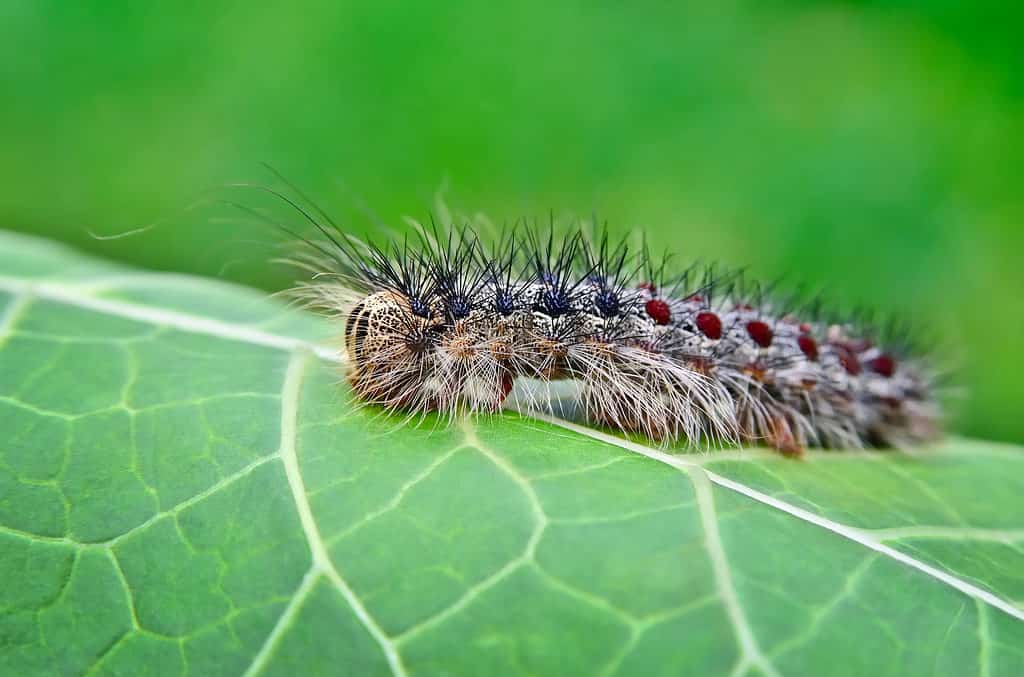
Spongy moth caterpillars (
Lymantria dispar) favor oak, willow, apple, cherry, and many other deciduous trees.
©Oleksandrum/Shutterstock.com
Tussock Moth Caterpillars: Control Measures
In attempting to avoid the destruction of forests and other habitats where tussock moth caterpillars are found, there are a variety of methods that are being used to control or eradicate tussock moths. Some of these include:
- Biological control: This involves the use of natural predators or pathogens to reduce the population of tussock moths. For example, parasitic wasps are introduced to target the eggs or larvae of the moths.
- Chemical control: Insecticides can be used to kill tussock moths. However, this method can be harmful to other non-target organisms and must be used with care.
- Cultural control: Though it seems counterintuitive, this method involves removing or destroying the host plants of tussock moths, as well as maintaining healthy trees and plants that can resist infestation.
- Trapping: Some farmers use pheromone traps to capture the moths, which is a more targeted approach to control.
- Removal: This includes removing the caterpillars by hand or using a vacuum to suck them up.
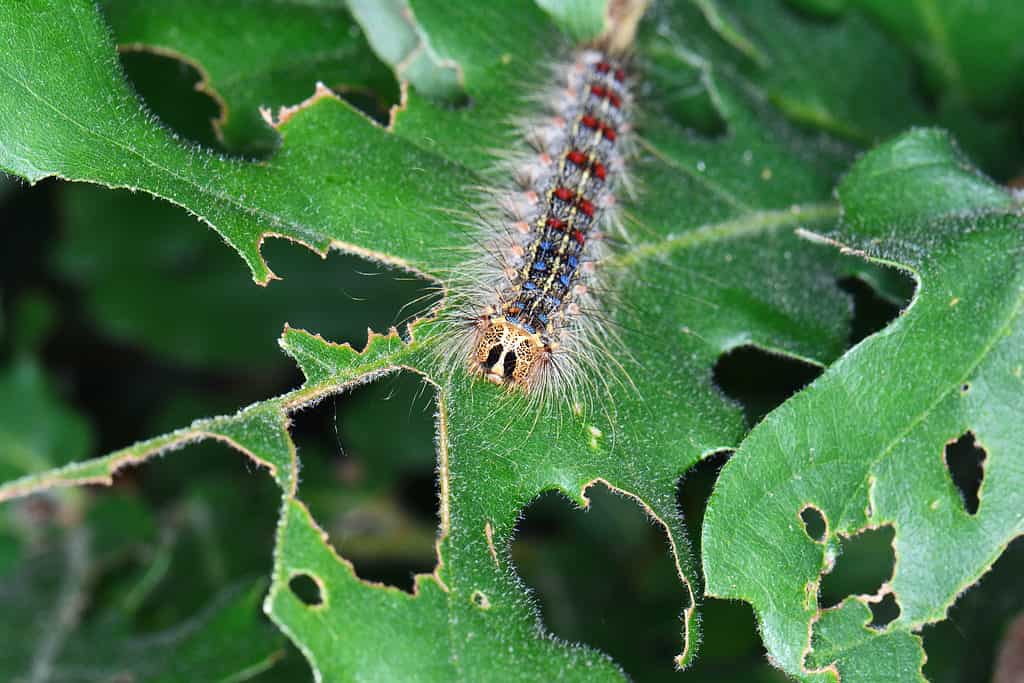
Spongy moth caterpillars, like the one in the photo, can
wreak havoc
on ecosystems.
©milart/Shutterstock.com
It’s important to note that the most effective control method depends on the specific species of tussock moth and their specific location and environment. A combination of methods is often necessary to achieve the desired results.
Tussock Moth Caterpillars: Predators
Tussock moth caterpillars face a variety of predators, including birds, mammals, and insects. Birds such as chickadees, nuthatches, and woodpeckers are known to feed on tussock moth caterpillars. Many species of mammals, including squirrels, chipmunks, and deer, also feed on tussock moth caterpillars. Additionally, insects, such as lady beetles, lacewings, and wasps, prey on tussock moth caterpillars. Parasitic Braconid wasps, like the Cotesia melanoscela and Apanteles melanoscelus, lay their eggs on the tussock moth caterpillars, and when the wasp larvae hatch, they feed on the inside of the caterpillars, eventually killing them. Some species, like the white-marked tussock moth (Orgyia leucostigma), have a symbiotic relationship with ants. The ants provide a distraction allowing the caterpillars to escape detection, generally from bigger, meaner ants. In exchange, the protector ants receive the sugars and amino acids secreted by the caterpillar’s dorsal nectary organ, a mutualistic relationship known as myrmecophily.
Tussock Moth Caterpillars: Threats
Tussock moth caterpillars face a variety of threats, including predation, disease, and exposure to extreme environmental conditions. They are also affected by other naturally occurring phenomena such as parasitism, viral and fungal diseases, and competition for food. Additionally, tussock moth caterpillars can be affected by human activities such as logging, urbanization, and pesticide use. Logging and urbanization can cause the destruction of their natural habitats, leading to a decline in their population. Pesticides can also be harmful to tussock moth caterpillars, both directly and indirectly, by killing them or by reducing the population of their prey or host plants. Climate change is also a threat to many species of tussock moths, as it can change the timing of their life cycle, and make them vulnerable to new pathogens, predators, and parasites.
Conservation Status
The conservation status of tussock moth caterpillars varies depending on the species. Some species are common and widespread, while others are considered rare or endangered. The International Union for Conservation of Nature (IUCN) Red List of Threatened Species is a widely recognized system for assessing the conservation status of species. However, tussock moth caterpillars are not specifically listed in the IUCN Red List, making it difficult to give an overall status for them as a group.
Some species of tussock moths such as the Gypsy Moth are considered pests and are targeted for control by various methods. On the other hand, other species of tussock moths are not considered pests. Some others are even considered indicator species, particularly those in the subfamily Lymantriinae, used for determining the health of certain habitats. For accurate current information regarding specific tussock moth species, best practices suggest consulting a local university, agricultural extension center, or conservation group.
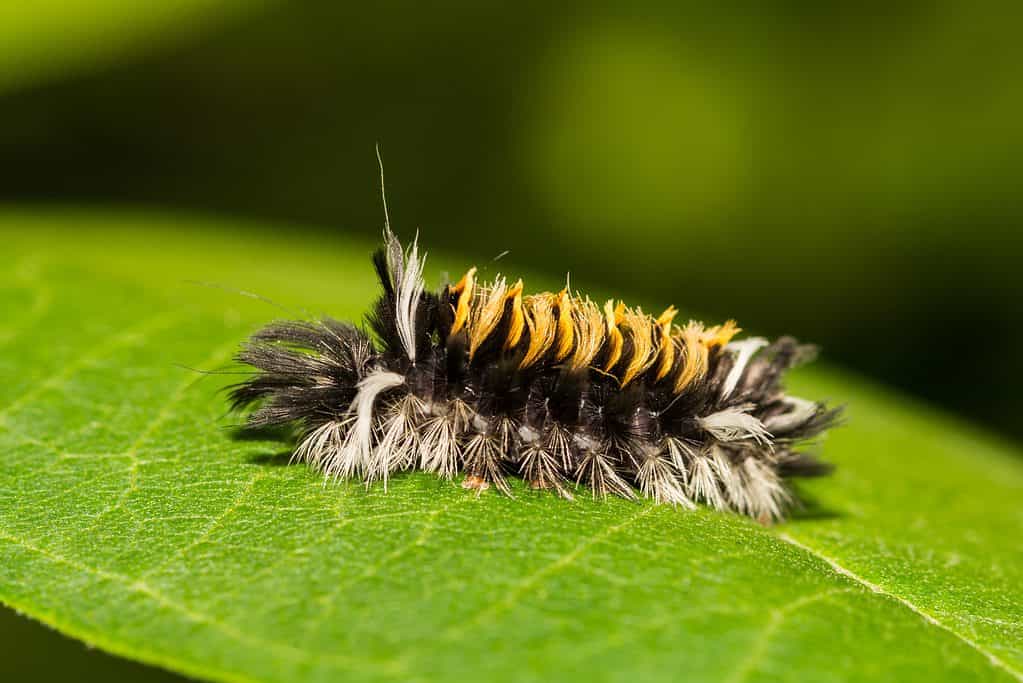
For current and accurate information regarding specific tussock moth species, like this milkweed tussock, consult a local university, agricultural extension center, or conservation group.
©Jay Ondreicka/Shutterstock.com
Lifecycle
The lifecycle of tussock moth caterpillars typically begins with the adult moths laying eggs on the leaves of trees and plants. The eggs are usually laid in clusters, hatching within a few weeks. Once they hatch, the caterpillars begin feeding on the leaves of their host plants. As they grow, they will molt several times, shedding their exoskeleton to reveal a new, larger one. The shedding of their exoskeleton is called an instar. Caterpillars will typically molt 5-6 times, or have 5-6 instars.
Tussock moth caterpillars are active during the day and they tend to rest at night. They continue to feed and grow until they reach their full size, which can take anywhere from a few weeks to several months, depending on the species. Once they reach maturity, the caterpillars will spin a cocoon or form a pupal case around their body in which they will metamorphose into adult moths. The adult moths emerge from the cocoon or pupal case after a period of time, which can be a few days to several weeks, depending on the species. In their adult form, they mate and lay eggs, beginning the cycle anew.
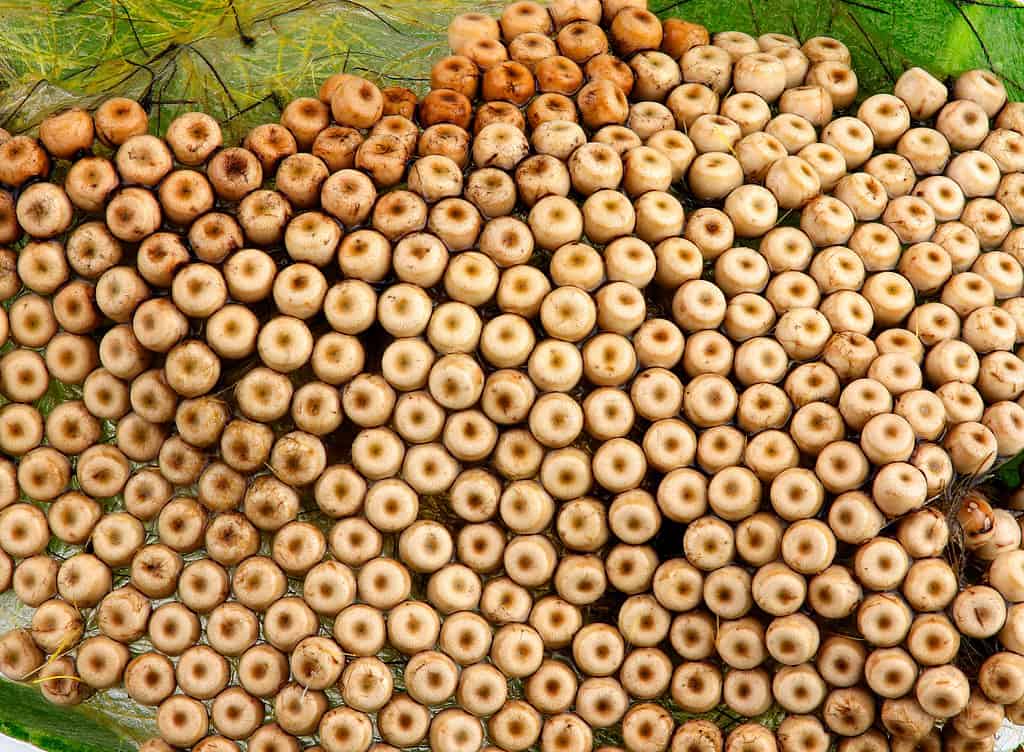
Tussock caterpillars begin life in eggs, like these vapourer moth (
Orgyia antiqua) eggs.
©Alex Coan/Shutterstock.com
Lifespan
The lifespan of tussock moth caterpillars can vary depending on the species and environmental conditions. The entire life cycle, from egg to adult, can take from a few weeks to several months. The eggs hatch within a few weeks, and the caterpillars typically go through several stages of growth, shedding their exoskeleton multiple times before reaching maturity. The mature caterpillars will then spin a cocoon or form a pupal case and metamorphose into adult moths. Adult moths live for a relatively short period of time, usually a few days to a few weeks.
Population
Population estimates for tussock moth caterpillars can vary depending on the species and the location. Some species are considered to be common and widespread, while others are considered to be rare or endangered. However, it’s hard to give a general estimate of population size for tussock moth caterpillars as it can fluctuate greatly depending on factors such as the availability of host plants, weather conditions, and predation. Additionally, tussock moth populations can fluctuate greatly from year to year and can be impacted by various factors such as weather, predators, and disease. Also, tussock moths are not specifically monitored by any agency, so there is no specific data on population estimates
Up Next:
View all 133 animals that start with TTussock Moth Caterpillar FAQs (Frequently Asked Questions)
Are tussock moth caterpillars venomous?
No! Tussock moth caterpillars are not venomous. Many tussock moth caterpillars have urticating hairs which can cause an unpleasant reaction in some individuals. However, reactions tend to be mild, and are the result of an allergic reaction. To treat a mild allergic reaction to urticating hairs: rinse the affected area with cool water, then apply a cold compress or calamine lotion to reduce itching and inflammation. Over-the-counter antihistamines may also be helpful in relieving symptoms. If the reaction is severe or if symptoms persist, it is important to seek medical attention.
What do tussock moth caterpillars look like?
Tussock moth caterpillars are small, fuzzy insects that can vary in color from yellow to brown to black. Many tussock moth caterpillars have urticating hairs, which can cause an unpleasant reaction in some individuals. However, reactions tend to be mild, and are the result of an allergic reaction. Tussock moth caterpillars are not venomous. They have tufts of hair, called setae (seta, singularly) along their bodies, which are their most distinctive feature. Some species have distinctive markings or patterns on their bodies as well. Most tussock moth caterpillars have earth-tone, or natural coloration to blend in with their surrounding, avoiding would-be predators.
What predators do tussock moth caterpillars have?
Tussock moth caterpillars face a variety of predators, including birds, mammals, and insects. Parasitic Braconid wasps, like the Cotesia melanoscela and Apanteles melanoscelus, lay their eggs on the tussock moth caterpillars, and when the wasp larvae hatch, they feed on the inside of the caterpillars, eventually killing them.
What do tussock moth caterpillars eat?
Tussock moth caterpillars are herbivorous, feeding on the leaves of various trees and plants. They can be found on deciduous and coniferous trees, shrubs, and other plants. The host plants vary depending on the species of tussock moth. For example, the caterpillars of the gypsy moth (Lymantria dispar) favor oak, willow, apple, cherry, and many other deciduous trees, while the caterpillars of the vapourer moth (Orgyia antiqua) feed on deciduous trees such as oak, birch. Some tussock moths are considered generalist feeders, eating what is available.
How long do tussock moth caterpillars live?
The lifespan of tussock moth caterpillars can vary depending on the species and environmental conditions. The entire life cycle, from egg to adult, can take from a few weeks to several months.
Thank you for reading! Have some feedback for us? Contact the AZ Animals editorial team.
Sources
- researchgate.net, Available here: https://www.researchgate.net/publication/355559318_Tussock_Moths_A_Bio-indicator_of_Disturbed_Ecosystems
- ufl.org, Available here: https://entnemdept.ufl.edu/creatures/urban/medical/tussock_moths.htm
- insectidentification.org, Available here: https://www.insectidentification.org/insect-description.php?identification=Definite-Tussock-Moth
- caterpillaridentification.org, Available here: https://www.caterpillaridentification.org/information.php?primary_name=southern-tussock-moth-caterpillar
- wikipedia.org, Available here: https://en.wikipedia.org/wiki/Erebidae
- amentsoc.org, Available here: https://www.amentsoc.org/insects/glossary/terms/urticating-hairs/
- wpmucdn.com, Available here: https://cpb-us-e1.wpmucdn.com/blogs.cornell.edu/dist/0/8622/files/2022/02/GreerMoreau_ISE_2022.pdf
















